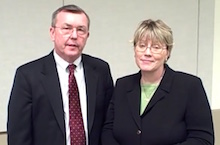How Leaders Grow a Positive School Culture
 By Ron Williamson and Barbara Blackburn
By Ron Williamson and Barbara Blackburn
When we’re working with teachers and principals, they often talk about the culture of their school. Sometimes it’s a positive discussion and other times not so positive. But almost always they’re commenting on the feeling or tone of their school, a description of school climate.
Climate often reflects the relationships among teachers, with families, and with administrators. Climate is as much a description of the morale of the school as anything, at a given point in time.
But culture is a far more amorphous concept that reflects deeply held values, traditions and patterns of behavior present in any school. Often those beliefs are so engrained into the fabric of the school that people don’t even think about them when going about their daily routines.
The street-level description of culture is “the way we do things around here.” It includes the unwritten rules and assumptions about schools and their purpose; the traditions and rituals transmitted from generation to generation among students, families and staff; and the language and expectations that staff and students use in their interactions (Peterson & Deal, 2002).
Every school has a culture, and that culture is learned and accepted by teachers, students and families. In fact, culture is so pervasive that most people don’t even recognize that they are acting based on these unspoken norms.
Ways culture manifests itself
The good news is that there is a model for understanding school culture and the way it manifests itself in a school (Bolman & Deal, 2013). Most important, leaders can positively shape their school culture by using the tools in this model to change the culture, and the unwritten assumptions present in their school.
Manifestations of culture:
• Rituals and ceremonies provide structure to our daily life and to the routine of a school. Rituals occur routinely whereas ceremonies are grander, less frequent events (graduation). Both rituals and ceremonies reflect values in their structure and priority, and they carry meaning about what is valued and what is important.
• 
• Stories and tales are recollections of events that are told and retold and play a powerful role in sharing examples of organizational values. Stories often contain a moral and are inevitably engaging.
• Rewards and reinforcements reflect those things that are valued and therefore rewarded. Is it creativity in the classroom or compliance with established patterns? Is it waiving a rule so that a student may be successful or adhering to a strict interpretation of policy?
What principals can do
It can be helpful to assess your current culture. Here are some questions you can use to guide the assessment.
| Cultural Factors | |
| Rituals and ceremonies | • Does your school have a set of rituals and routines that communicate your values about student learning?
• Are there special events that demonstrate to your school’s mission and vision? |
| Heroes and heroines | • How do you recognize and celebrate people who contribute to the success of every student?
• What ways do you use to recognize students and teachers who exemplify commitment to your school’s mission? |
| Stories and tales | • What stories do you tell about your school, about students and staff?
• What do you say to share your commitment to your school’s mission? |
| Rewards and reinforcements | • Do you routinely reward students and teachers who do things that support your school’s mission?
• How do you recognize and reward people for their work? |
Watching for opportunities
Once you’ve finished the assessment, you can zero in on things you can do to influence the culture in your school. Principals shape culture by the things they pay attention to. In most schools it’s readily apparent what a principal pays attention to and values. Culture won’t change because a principal mandates that it change. It changes a little bit every day as you re-enforce the values and beliefs that are important to you.
Think about the patterns of regular activity in your school. What are the values that those activities re-enforce? How do they visibly emphasize the things that are important? What messages do those routines send to teachers, students and families? What do they say about who can be successful? Who is provided an opportunity for leadership? How do they suggest the behaviors and activities that are valued?
Actions to reinforce values
Here are some ways that a principal can shape their school’s culture. Each is a way to convey those values that you want to use to shape the culture of your school.
-
- Develop a set of stories about student and teacher success. Use every opportunity to share those stories with teachers, families and community.
- Think about how you spend time during each day. Maximize the time you spend in classrooms and find time to talk with teachers about their instruction.
- Value being part of professional development by attending with your teachers. Join book study groups, attend team meetings, and look at student work.
- Review the use of your school’s budget. Assure that the budget supports the school vision and does not simply follow past practice.
- Consider how teachers, staff and students are recognized and their work acknowledged. Make sure recognitions are authentic and support your school’s mission and vision.
Final thoughts
Rituals, ceremonies, stories, and rewards and recognition are the most visible indicators of what is important and valued. Because of the powerful way culture shapes the activity of those who work in a school, and those who visit, it’s worth investing the effort to assure it sends a positive message.
References
Bolman, L. G. & Deal T. (2013). Reframing organizations: Artistry, choice and leadership (5th ed.). San Francisco: Jossey-Bass.
Peterson, K. D., & Deal, T. (2002). The shaping school culture fieldbook. San Francisco: Jossey-Bass.


Feature image: Victoria Choi, USAG – Humphreys






































Distributive Leadership, beyond just titled leadership, is the key to systemic change. http://scottspringston.com/2016/02/5-traits-of-successful-leaders/